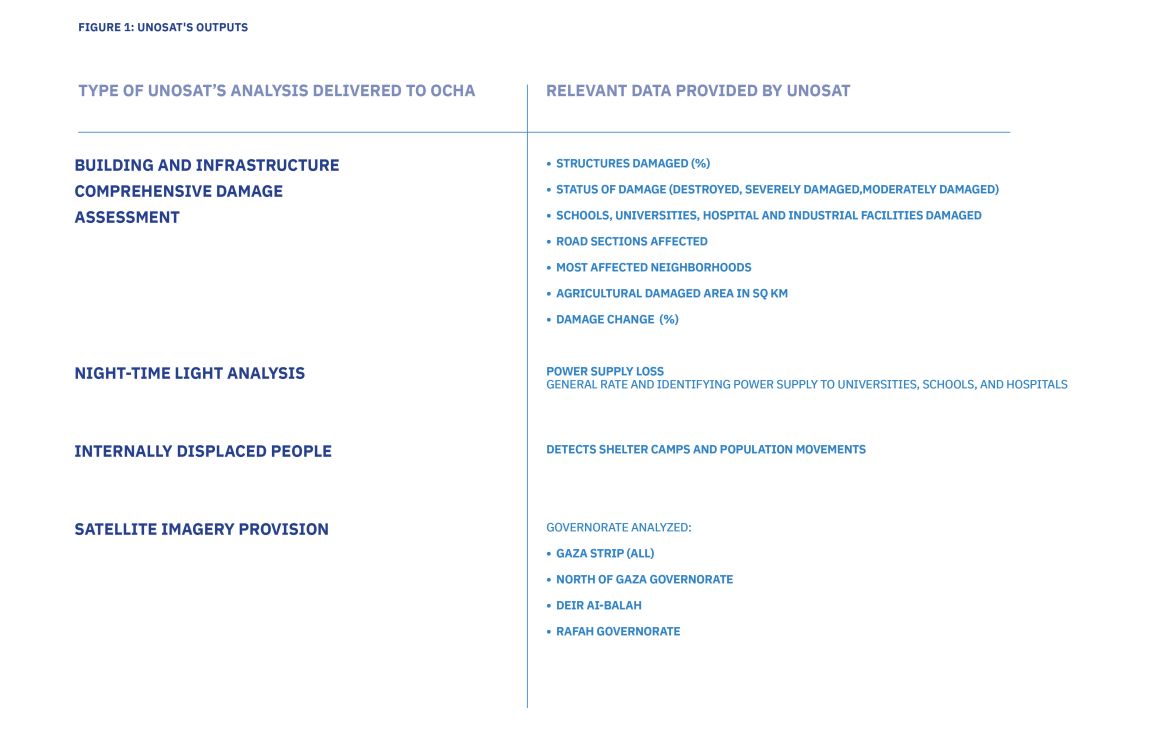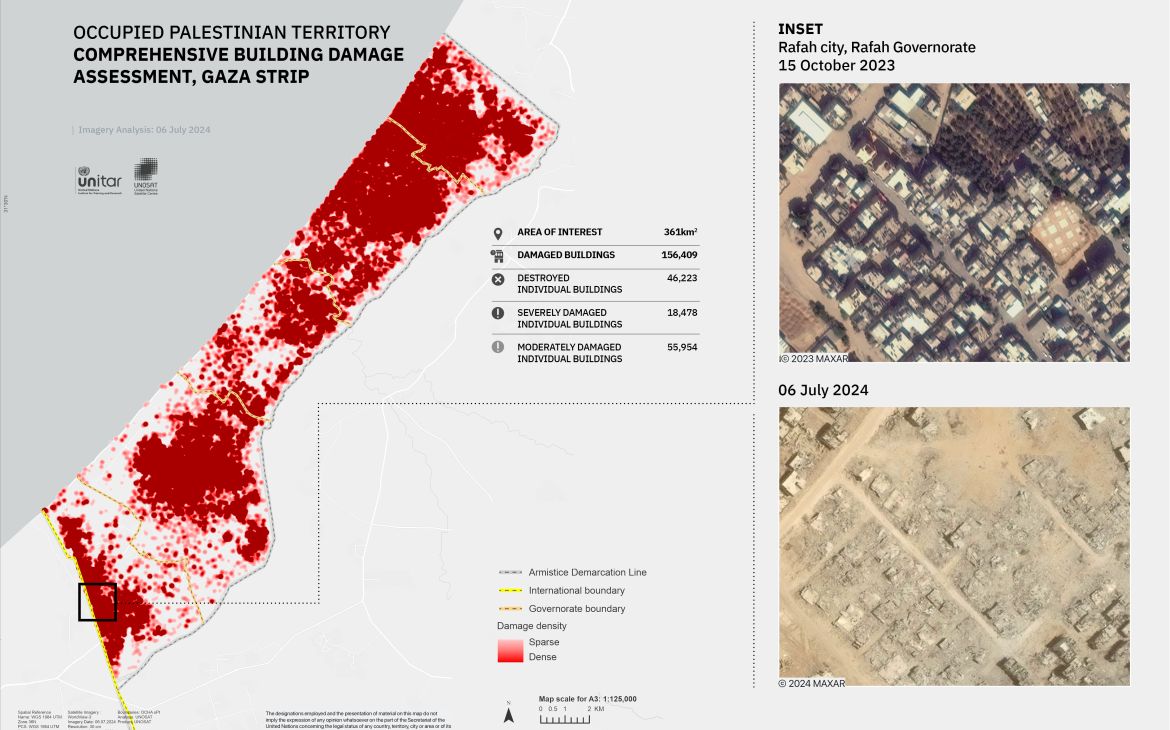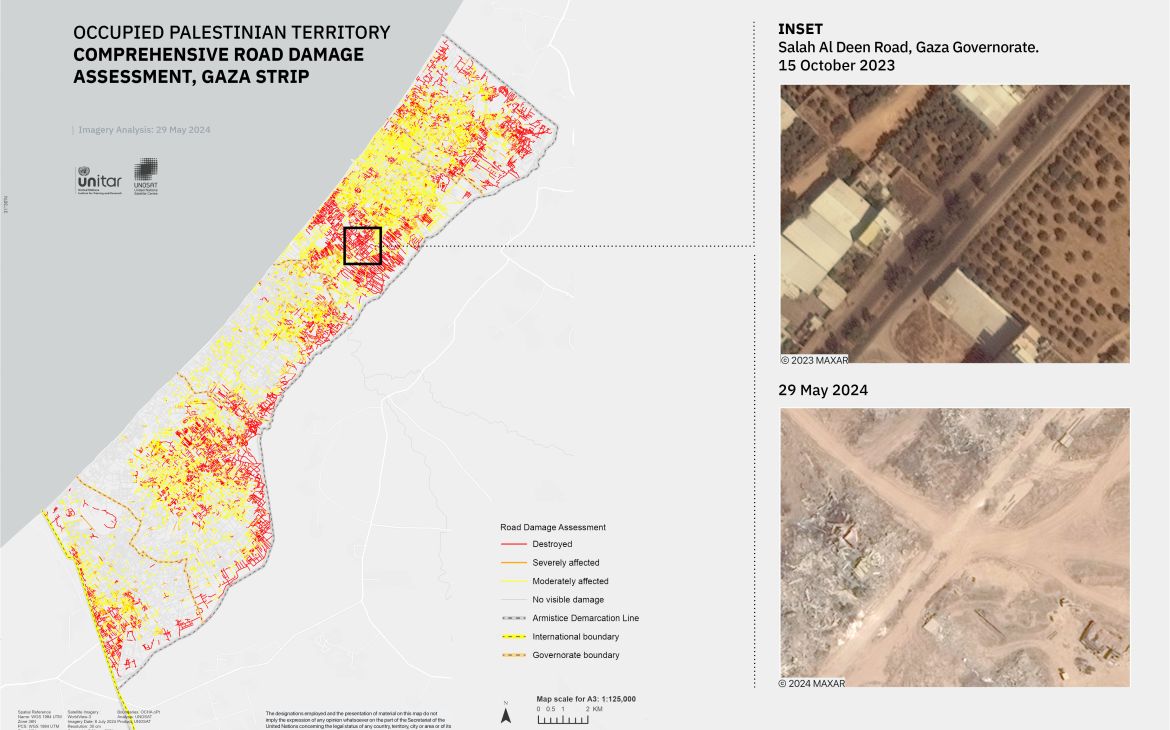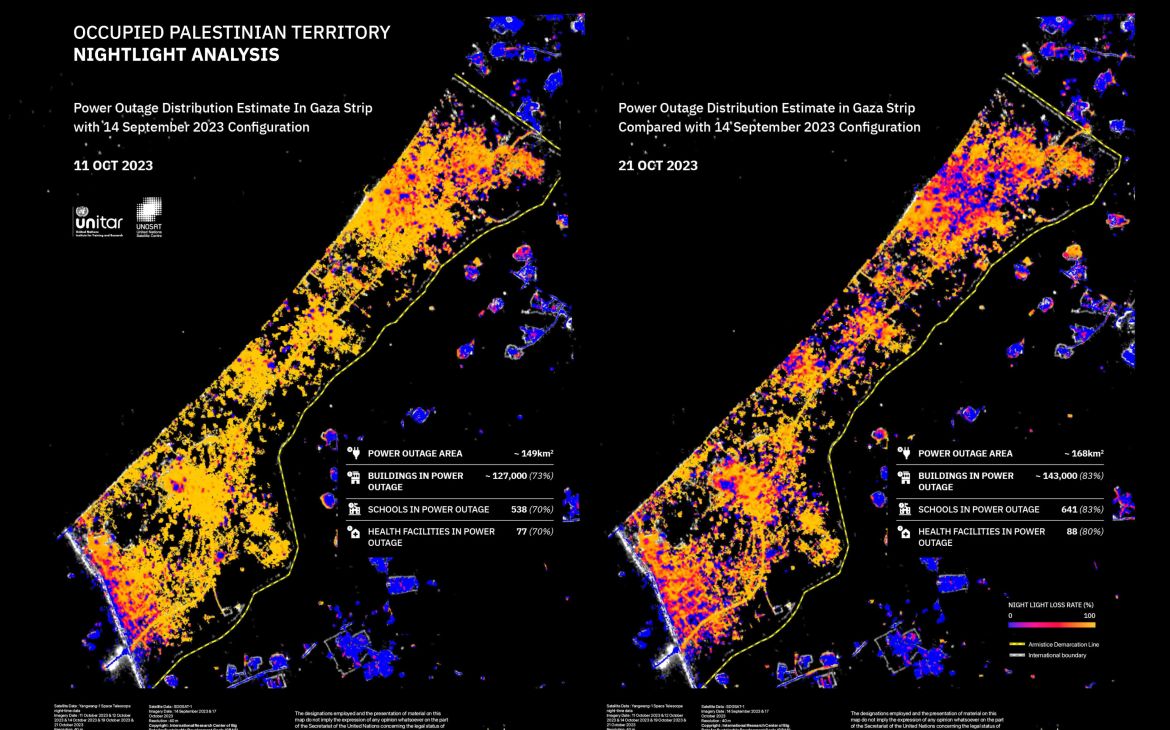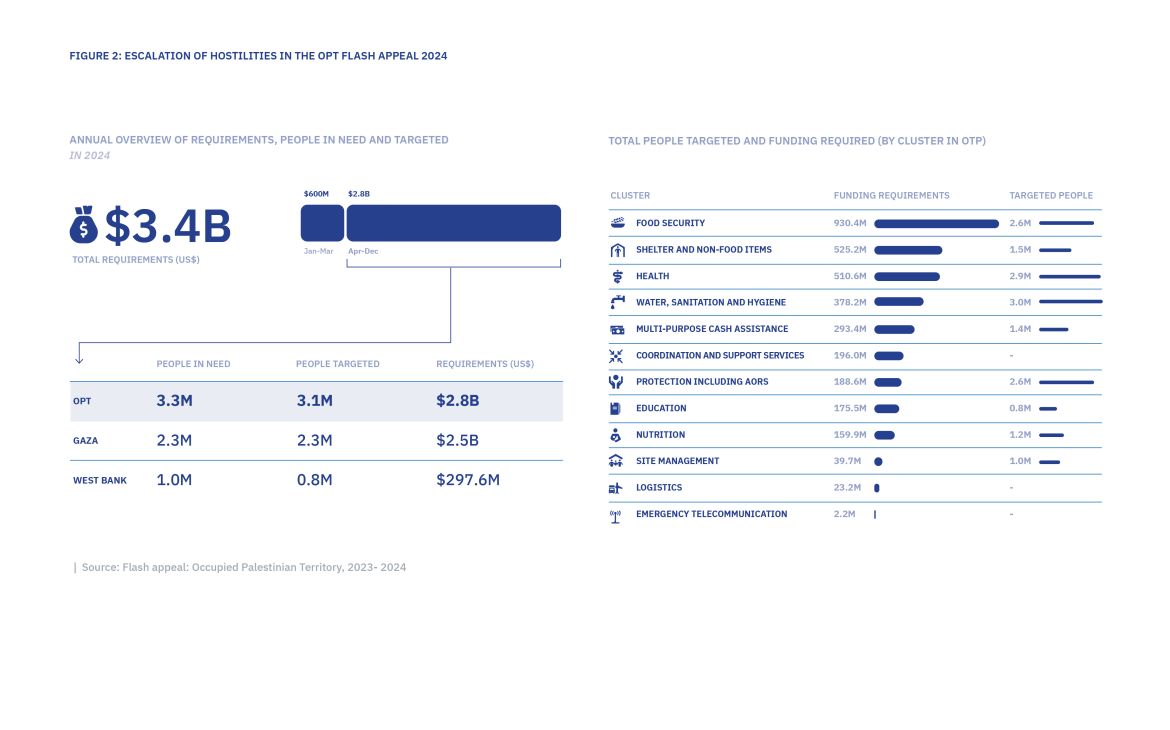Emergency Mapping Service of the United Nations Satellite Centre (EMS-UNOSAT)
The increase in disaster occurrences and the high numbers of victims resulting from conflicts are urgent issues that require effective and rapid action. Satellite imagery analysis is a vital tool essential in this response, as it can cover large areas and provide accurate information in near real time.
The Emergency Mapping Service (EMS) at the United Nations Satellite Centre (UNOSAT) supported by funding from the Norwegian Ministry of Foreign Affairs (NMFA), delivers satellite image analysis during humanitarian emergencies/crises that stem from disasters, complex emergencies and conflicts. With a 24/7 year-round availability to process requests, the team of experienced analysts ensure timely and tailored delivery of satellite imagery derived maps (both web and static maps), reports and data ready for direct inclusion in Geographic Information Systems (GIS) for evidence-based decision making and operational planning.
The Crucial Role of UNOSAT in Supporting OCHA's Humanitarian Efforts in Gaza
OCHA OPT (Office for the Coordination of Humanitarian Affairs in the Occupied Palestinian Territory) activated the Emergency Mapping Service due to the escalation of conflict in Gaza since the 7th October 2023. OCHA's mandate includes mobilizing and coordinating effective humanitarian action in partnership with national and international actors. In complex emergencies like the Gaza conflict, OCHA OPT is tasked with coordinating the assessment of humanitarian needs, so that aid reaches those who need it most, developing humanitarian response plans, and monitoring the situation.
UNOSAT's satellite imagery analysis became a crucial source of primary objective information for humanitarian responders facing the unprecedented crisis in Gaza. Due to security concerns that made traditional on-the-ground data collection unfeasible, OCHA relied on UNOSAT's expertise to guide their efforts.
Without UNOSAT, it would be difficult to obtain accurate and up-todate information on the level of destruction says Majed Abuqubu, head of Information Management at OCHA OPT. "Given the level of insecurity and attacks against humanitarian organizations, where many of our colleagues have been under huge security risk, UNOSAT's satellite analysis proved to be indispensable."
Since the 7th October 2023, OCHA OPT requested over 25 products including comprehensive building and infrastructure damage assessment, baseline damage assessment, night light damage assessment, satellite imagery provision and agricultural damage assessment (Figure 1).
The partnership between OCHA-OPT and UNOSAT yielded several significant outcomes:
ENHANCED EVIDENCE-BASED DECISION MAKING
UNOSAT's Comprehensive Damage Assessment provided OCHA OPT with detailed reports on destruction at governorate and municipality levels, including the status of critical structures and lifeline facilities. This granular data enabled OCHA to make informed decisions about resource allocation. As explained by Abuqubu, "If the level of destruction is over 60 or 70 per cent, we could easily estimate the percentage of those people who have already left." This precise information allowed OCHA to prioritize areas with the highest needs effectively. UNOSAT's night light analysis offered crucial insights into power supply loss and population movements. Abuqubu observed that, "The night light analysis, at the beginning of the crisis, gave us a good indication where people have moved [...] It gave us an indication about the provision of electricity and services."
IMPROVED COORDINATION AND PLANNING
UNOSAT's analysis of affected road sections was instrumental in OCHA OPT's field visit preparations. Abuqubu specified that, "UNOSAT has helped us in identifying the best routes and where the rubble is blocking roads. We were trying to send humanitarian convoys from the southern part of Gaza-Rafah Governorate where the services were functional and most of the humanitarian organizations were based to the north – Gaza and north Gaza Governorates."
This information enabled OCHA to recommend optimal routes for medical evacuations and delivery of supplies. A notable example was the successful evacuation of 39 newborn children from incubators to Arish Hospital outside Gaza.
UNOSAT's timely imagery and analysis also provided assessments of new crossings and newly established military roads and checkpoints. Abuqubu noted, "We were able to show the new entry points and the logistical facility using satellite images." The temporal analysis of humanitarian aid channels provided OCHA with crucial information for planning and coordinating aid delivery.
TARGETED RESOURCE ALLOCATION AND STRATEGIC PLANNING
UNOSAT's analysis was used as one of the credible sources of information to inform the flash appeal on critical needs and the level of destruction” Escalation of Hostilities in the OPT Flash Appeal 2023-2024”. This plan outlines the estimated resource requirements to reduce human suffering and prevent further loss of life in Occupied Palestine Territory. According to the Appeal Plan, around 3.3 million people in OPT are in need in 2024, with plans to assist 3.1 million people, requiring a budget of 3.4 billion USD.
As of the latest update, 48 per cent of the Plan is funded, amounting 1.6 billion USD. This funding is sourced from various donors, with contributions from the Government of United Arab Emirates, European Commission, Government of Germany and the Government of Japan, collectively contributing 55 per cent of the funding received. The plan encompasses multiple sectors including education, food security, health, nutrition, protection, water sanitation and hygiene, among others, ensuring a holistic approach to addressing the crisis. (Figure 2)
REINFORCED SYNERGIES AND COORDINATION AMONG HUMANITARIAN ACTORS
To improve coordination, a centralized data hub was established for Information Management (IM) officers to share information with cluster coordinators, information managers, and the civil-military coordination team, enabling access to the data provided by UNOSAT.
Abuqubu highlighted “We have a provision of services map. [..]on food, health, IDPs sites, and lifeline facilities level of destruction and functionality."
The "UNOSAT Gaza Emergency Response Data Hub", is a comprehensive platform that provides access to UNOSAT's geospatial data for the Gaza Strip. It features interactive dashboards that show damage assessments. The available data includes UNOSAT's analysis products, such as assessments of building and road damage, cropland analyses, and additional layers showing locations of healthcare facilities and schools.
This data hub served as a common reference point for various humanitarian organizations operating in Gaza, fostering better coordination, and leading to a more coherent and efficient overall response.
ENHANCED AWARENESS OF SATELLITE IMAGERY'S VALUE
The collaboration demonstrated the power of geospatial technology in humanitarian response, especially in complex emergencies where traditional methods fall short. Abuqubu concluded, "I could not imagine myself delivering and doing what I have done for the Gaza operation without having UNOSAT. I think this is a new era or new type of emergencies where the satellite damage analysis proved to be valuable and indispensable in such a situation."
This increased awareness extended beyond OCHA to other UN agencies and NGOs involved in the Gaza response, leading to a growing recognition of the value of satellite imagery in crisis response.
INCREASED PROTECTION AND HUMAN RIGHTS MONITORING
The detailed damage assessments and analysis of military checkpoints contributed to human rights monitoring efforts, offering objective evidence of the conflict's impact on civilian infrastructures for use by human rights organizations and UN bodies in their reporting, investigative and advocacy work.
The satellite imagery-based analysis provided by UNOSAT were critical to OCHA-OPT humanitarian coordination in the field. They provided accurate, timely, actionable data which have allowed them to respond more effectively to the needs of the affected population in Gaza. This collaboration exemplifies the crucial role of innovative geospatial technologies in modern humanitarian efforts, particularly in complex emergencies where access to the ground is impossible.
References
- United Nations Satellite Centre (UNOSAT). (n.d.). UNOSAT's Emergency Mapping Service (EMS). Retrieved from www.unosat.org/services
- United Nations Office for the Coordination of Humanitarian Affairs (UNOCHA). (2024, April 17). Flash appeal: Occupied Palestinian Territory, April - December 2024. Retrieved from https://www.ochaopt.org/content/flash-appeal-occupied-palestinian-territory-2024
- United Nations Satellite Centre (UNOSAT). (n.d.). UNOSAT Gaza Emergency Response Data Hub [Data portal]. Retrieved from https://gaza-unosat.hub.arcgis.com


